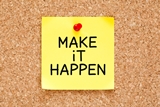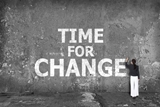
We talk a lot about preparing yourself to hit a homerun presentation. Our IMPACT: How To Speak Your Way To Success program gives individuals the tools they need to better deliver: good eye contact, open body posture, using pauses, etc.
We do not talk much about setting another presenter up for a homerun. But it will be the first impression the audience members have of the speaker, even though they haven't made their appearance.
Every speaker deserves a thoughtful and helpful introduction. The best introductions are two-way, just as personal introductions are. You introduce the speaker to the audience and the audience to the speaker, establishing a common bond between them. You will need to use your IMPACT skills and consider these items:
Elements
Your introduction should grab the audience's attention and make the audience aware of the importance of the upcoming talk.
An effective introduction answers these questions:
Why this subject?
Why this speaker?
Why this audience?
Why now?
Titles
Don't use lengthy titles unless the speaker's title is a familiar one to the audience or a real attention-getter such as:
President of...
Inventor of...
First person to...
Author of...
Winner of...
Set the Mood
Tell the audience about the expertise and background of the speaker. Set the mood while being careful not to give the speaker's presentation. Arouse interest without taking away from the speaker's IMPACT. Weave the speaker's name into the introduction as much as possible unless it is a surprise name that the audience will recognize.
Timing
Shorter is better. An introduction should never be longer than two minutes.
Preparation
Contact the speaker in advance and discuss the relevant information. Make an outline and rehearse it. Never read an introduction. Good preparation will clearly show and the speaker and audience will appreciate it.
Shake Hands
Never let a speaker arrive to an empty stage after an introduction. Always wait for them, shake their hand, and then sit down.

Why are there so many misunderstandings? Why can't people interpret my messages exactly how I intend them? Filters.
It is hard for us to effectively listen because we all have our own filters. We might all hear the same word but have differing thoughts on what exactly that word means.
Take a look at diagram below. This is just a small set of the filters we possess. You can see that what we hear, is influenced by our beliefs, values, interests, strong feelings, good and bad experiences, memories, expectations and plenty more filters.

Because everyone's filter is different, the same word may produce different effects. Consider this example:
Bill and Janice get into a disagreement about what brand of coffee should be used in the office. Suzy was there to witness this disagreement and shares what with a few other co-workers in the office. Suzy's story goes something like the following:
"I was walking down the hall to scan a few documents and noticed Bill and Janice in the kitchen having a disagreement about..."
Before Suzy goes any further with the story, the two co-workers listening quickly interpret what she means by "disagreement".
Let's see how the filters might come into effect as this "disagreement" spreads around the office:
One person (A) might filter the word disagreement as "conflict"
Another person (B) filters disagreement as "discussion"
When the two parties (A and B) tell two other people (C and D) about the incident, the person who heard "conflict" might tell their colleague (C) who hears "conflict" but filters "fight"
At the same time person (B) might tell a colleague (D) you had a "discussion" and person (D) filters the message as "conversation"
Thus from one word "disagreement" people could end up filtering things as different as "conversation" or "fight!"
Additionally, even when a word means the same thing to people, for some it might evoke a mild reaction and others a strong reaction - depending on the filters.
What do your filters tell you when you hear the word "disagreement"?

Humans have proportionately the biggest brains in the entire animal kingdom. We have about 11.5 billion neurons in our brains. One would be smart to point out that our brains have evolved to solve complex problems to enable us to survive. There is another primary driver with increasing evidence to explain our enlarged brains: to facilitate our social cognitive skills.
Matthew D. Lieberman, Professor at the University of California and author of the book, Social, has studied and found groundbreaking research in social neuroscience. Here is a profound statement from Lieberman's book:
All these years, we've assumed the smartest among us have particularly strong analytical skills. But from an evolutionary perspective, perhaps the smartest among us are actually those with the best social skills
A lot of Lieberman's book discusses why our brain are wired to connect. Even an introverted person needs to have social interaction to survive. Another interesting point that we might not usually think of is how our social network affects our health. Consider this point from Lieberman:
Having a poor social network is literally as bad for your health as smoking two packs of cigarettes a day
Wow. That has incredible implications for us. Another finding is the heavily talked about discussion. Does money make us happy? Probably a better question might be: does being social make us happier than money? Let's look at both of these questions in order.
Does money make us happy?
If you won the lottery today, how would your life change? It would probably change considerably because you'll do all the things you have wanted to do: dig your way out of debt, buy a new house/car, take a trip around the world - anything you can think of is probably possible.
It's true. You would be able to do all these great things and probably wouldn't have to work ever again if you were smart with your winnings. Hedonic adaptation would like to point out that we as humans, have the tendency to adapt to new circumstances, whether good or bad. Meaning, you might have a spike of happiness from winning the lottery, but eventually it will fade away and become normal for you. The excitement doesn't last forever.
This is not to say money doesn't play a major factor in our happiness - it does. But it is to a certain point, then we need more than what money can buy. Which leads us to our second question.
Does being social make us happier than money?
It is only fair to bring these two in an apples to apples comparison. Multiple studies have actually been able to put a dollar value on how much our social aspects are worth in terms of our well-being. Take a look:
Volunteering once a week - increases well-being equivalent from a $20,000 salary to a $75,000 salary
Having a friend you see on most days compared to not having that such friend - is worth an extra $100,000 a year
Being married? Another $100,000
Getting divorced - is like slashing your salary by $90,000
Seeing your neighbor regularly - $60,000
I think you get the point. We are wired to connect and be around people. What is one thing you can do this week to feed the social part of your brain?
Tero Take
The heart of our business is teaching how to effectively communicate and connect with others. Technology is making it harder to make effective and frequent communication happen. Sometimes we forget it should be human to human interaction. Our world is becoming a human to technology interaction instead. Research is clear that communicating with others is important for success in life, we must also remember it is important for our well-being.

Primacy and Recency are key components to all of your interactions. Are you aware of what the terms mean? They determine a great proportion of the perceptions people have of you.
We've all heard the saying, "You'll want to make a good first impression." When you are meeting someone for the first time, they literally have no idea who you are (unless they heard about you through someone else). The way you dress, the way you introduce yourself, how you hold yourself all play a role in the other person building a perception of you. This may not give them an accurate picture of who you are and it's only been a matter of minutes, or seconds. This is known as Primacy. Primacy is where you set the tone for the rest of the interaction. This can be a networking event, meeting with a client for the first time, or even giving a presentation.
On the other end you have recency. This is where you close off the interaction and want to end on a good note. A lot of people seem to forget to end strong. This is the person at a networking function who walks away from the conversation without a handshake, or the person who ends a presentation with something like, "So, that's about it for my presentation..." Recency is really an opportunity you should take advantage of. Bring the excitement like you are seeing an old friend or you just bought that sports car you've always wanted.
Leveraging this knowledge puts you in a great position to be successful in all of your interactions.

Yes, it's true. A goldfish is able to pay longer attention than you. This has incredible implications for presentations and if your audience is engaging or not. Of course you want them to engage, you spent a lot of time prepping to knock it out of the park. For illustrative purposes, here are three statistics recently found in researching attention spans:
Average attention span in 2015 - 8.25 seconds
Average attention span in 2000 - 12 seconds
Average attention span of a gold fish - 9 seconds
Source: Harald Weinreich, Hartmut Obendorf, Eelco Herder, and Matthias Mayer: "Not Quite the Average: An Empirical Study of Web Use," in the ACM Transactions on the Web, vol. 2, no. 1 (February 2008), article #5.
It's frightening to think that in 15 years, we've dropped a quarter of our attention span. Who's to blame? Technology? Our working environment? Let's not worry about that right now. The major problem is that it is becoming increasingly harder to get and keep our listeners attention. Think about it in the context of a presentation. How many times do you think audience members are day dreaming? Or worrying about what they will eat for lunch? It doesn't necessarily mean you have a boring presentation, but that could be the case.
We can only expect this to trend towards even shorter attention spans unless there is a major cultural shift to fix this prevalent problem. We are not able to directly change an audience's natural attention span. But, you are able to change your own behaviors to engage the audience and provide an optimal learning environment.
Consider these 3 quick tips to use to engage your audience members:
Posture and Movement
On average, standing increases heartbeats by 10 extra times per minute. That sends more blood to the brain, which activates the central nervous system to increase neural firing. When learners find their energy level dropping, get them to stand up for 2-3 minutes as an energizer.
Storytelling
You can get your point across in less time, with better understanding and with longer retention if you use stories. Stories are so effective that people will sometimes remember them forever. Stories give people an emotional frame of reference on which to relate personally. Stories are effective because everyone has their own story and can imagine or envision themselves participating in the story to which they are listening.
Be Brief and Finish Early
Our fast-food, TV, information society has set new standards for all presenters - we must be concise and brief. People were once willing to listen to a speaker for an hour. Today, even the clergy has to limit its messages to about 20 minutes or less. Interviews on talk shows ran 15 minutes at one time. Now they rarely last more than 7 minutes. TV interviewers used to allow a guest the luxury of a one-minute response. Today that has diminished to less than 25 seconds. How many presentations have you attended that finished early? Compliment your audience by finishing five minutes early. Be aware of time management from the very beginning of your presentation. Plan how long each stage of your talk should take and stick to it.

Even for the most seasoned of presenters, there is a level of nerves or butterflies before a presentation. There are a lot of variables or unknowns that are in play. Will the audience be engaged? What if this presentation flops? Hopefully everything goes as planned...
There are certainly many things that are out of your control and that can be overwhelming. What is in control though, is how you feel. You are going to want to feel and be calm, so you look calm. Easy enough?
Let's get right into it. Patrick Allan published an article on lifehacker going over several things you can do to calm your nerves before a presentation.
Here are 4 of the tips he suggested:
Practice Where You'll Speak
A lot of the stress and fear comes from the unknown. You don't know what's going to happen. You can reduce the fear factor some by eliminating as many unknowns as you can.
Stay Hydrated and Exercise
Dehydration can make you feel tired and it can make your mouth, throat, and lips dry. Make sure you're drinking water throughout the day.
Exercise helps too. A good workout can help you reduce overall stress for the rest of the day. You'll get those endorphins pumping and it will keep you out of your own head. If you don't have time to do a workout earlier, a few minutes of some vigorous exercise beforehand can help too.
Take Deep Breaths and Visualize a Simple Object
Taking slow, deep breaths helps lower your heart rate and change your mindset from "fight or flight" mode to "relax" mode. Gary Genard suggest visualizing a simple object at the same time to help your focus:
...focus on a visual image you can see in your mind. Make that image a colored shape - a green circle, a yellow square, a blue triangle. Choose any object that doesn't have emotional overtones (whatever you do, don't pick red; red is a real rage and anxiety color). See that object in as close to crystal clarity as you can. This will take concentration and you'll need to practice to perfect it. Other thoughts, images, and feelings will emerge; notice them and let them go. Keep a gentle, persistent focus on your image.
Stay focused on that image and make your breaths slower and deeper as you go.
Warm Up Your Body and Voice
When you're giving a speech, your voice becomes an instrument. If you're afraid of your body betraying you somehow, simple warm up exercises can help alleviate your concern. Just like an instrument, your voice needs to be properly tuned before you can start rocking the mic. Start with warming up your voice. Practice enunciation with tongue-twisters and other similar exercises to get your tongue, lips, and jaw ready to go. Breathing exercises designed to help your voice projection are helpful too.
There are plenty of other things to worry about that go into making an effective presentation. These suggestions help you eliminate a lot of the worry and help you focus on what's really important: giving the audience a show.
Click here to read the original article.

We often times let other's determine what we can and cannot accomplish. We believe that what they are saying is fact. This will get our little voice in our head saying things like, "Maybe I won't be able to get that promotion this year" or "I'm terrible at small talk. I should avoid networking opportunities." Sometimes you even fabricate these thoughts yourself, without anyone coming out and saying it. All this leads to demotivation to challenge yourself and succeed.
Michael Hyter, Former Chairman and CEO at PepsiCo, refutes this thinking:
You are capable of learning whatever is necessary to achieve your goals. You are capable of becoming the person you dream to be.
I'm sure you are weary to believe this statement to be entirely true. But, it is true. Everyone has their doubts in their own abilities. Even as a seasoned professional and are very confident in what they can do. But, those that succeed make progress through the right strategy, persistency, and self-belief.
Let's go back to Michael Hyter for a deeper understanding. In his book, The Power of Choice, Hyter illustrates this model:
The Fixed-Capacity Mindset
Our society has a belief that some people have "it". They are born to be a leader, salesperson, engineer, designer, teacher, and on and on. To some extent, that may be somewhat true that certain people are born with distinct traits that make them better off in a certain environment.
In the fixed-capacity mindset, professionals with a high IQ will be able to master the increasingly complex demands of their careers. Individuals with less capacity will reach their "level of incompetence" - they will give up because they find it difficult or impossible to develop the expertise to accomplish these complex goals.
In short, with fixed-capacity mindset, failure is viewed as evidence that the job or task is beyond our ability.
The Capacity-Building Mindset
Research confirms the capacity-building mindset is more accurate. We as humans are not fixed. Most people can develop new skills and capabilities and can learn to be highly effective at a variety of challenging new tasks.
Everyone can learn, if they apply effective effort.
Effective Effort
Effective effort is about working hard, EFFECTIVELY. Meaning, you will need to be strategic in your hard work.
Here are Hyter's three characteristics to effective effort:
Tenacious Engagement - willingness to give your time, energy and thoughtful observation to the process.
A Focus on Feedback - when the results are in, ask yourself appropriate questions. What happened? Why did it happen? What feedback and coaching can you get from others?
A Strategy for Improvement - Use the feedback to set priorities and put together a strategy for development. What will make you more effective?
You are capable of learning whatever is necessary to achieve your goals. You are capable of becoming the person you dream to be.
Tero Take
This book really hits home with what we believe at Tero. We take people at whatever level they are presently at in presenting, negotiating, networking, etc. and guide them through relevant researched skills to become better. An important part to developing a strategy around using critical soft skills is knowing what to work on. Practicing the wrong thing, over and over, will only solidify bad habits. Effective effort is in knowing and practicing the 'right' thing. Pairing consistency with strategy and the appropriate skills, you will be able to exceed your present level and succeed.

Most of us are terrible listeners. Sure, we might hear people. But a lot of the time, we are not actually comprehending what they are saying. We won't get into the reasons why we are terrible listeners (yet).
Take this example to illustrate the point of our poor listening skills:
Picture going on a fantastic trip to the Bahamas this winter to escape the frigid cold. What's one of the first things you will do when you come back from the trip? Tell all your friends. You tell them about all the great restaurants you ate at, beaches you laid out on, people you met, and even the time you embarrassingly fell face first into a cabana. In short, it was a great time. The first person you tell your wonderful adventure to, will probably only remember about 60% of what you said and miss a lot of the finer details. They are essentially summarizing. If this person were to tell another person, it would lose even more details of your trip. By the 5th person, they really only remember that you had a good time and also fell into a cabana (or about 20% of the original message).
Think about these implications in your workplace. Have you seen this happen before? Messages can often times be misinterpreted and then passed down to another person, changing it completely. Getting a fifth of the original message has never resulted in anything good. Let's look at ways to avoid this communication breakdown.
Strategies for overcoming listening barriers
Take notes.
Ask questions and clarify.
Repeat back (paraphrase) key points to check understanding.
Consider the source (before you believe the information, consider whether or not the source is reliable and if what they are saying makes sense).
Go back to the original source of the story.
Acknowledge that communication breaks down.
Communication is becoming increasingly more difficult with an extremely distracted work environment (thank technology). Putting these strategies to use will give you a better chance at understanding the whole message, and just as importantly, passing on a more accurate message.

You've just finished your presentation. You feel great. Now time for the questions. We as presenters want to encourage questions. We would prefer not to have the questions where we do not have an answer. I'm sure that has happened at some point.
Even if you are an expert, there are time where you can be stumped. Try these ideas the next time you are unable to answer a question:
Don't bluff. 'Fess up'.
Try the boomerang technique. "I don't know, what do you think?"
Defer the question to someone else in the room who might know the answer. Caution: only defer to someone else if you are confident they will handle the question professionally. It is still your credibility on the line.
Invite the questioner to speak to you after the presentation when you can write their question down.
Have them write their question down and provide it to you along with their business card after the presentation is over.
If you are compelled to answer and are not absolutely sure of your facts, state that to your listeners.
Bonus: Sometimes you might be faced with a rambling questioner. You are going to want to make sure the rest of the audience understands the question. Rephrase and simplify the question to help refocus the discussion for others.

Trying to grab someone's attention is difficult. Especially in a presentation. People are bouncing around between a myriad of items in their head. What am I doing this weekend? Will I be able to meet my project deadline? Am I on the right career path? Don't forget to pay off your credit card bill. These chairs are not that comfortable. Who just texted me?
If you come out flat as a presenter, you will not be able fight for your right to be heard amongst all these other thoughts. But, you want to be engaging and memorable. You need to be. If you cannot get them to pay attention, then it is not worth all the effort to prepare and the courage it takes to present.
There is a lot of creativity and ingenuity required to gain attention, but here are 9 strategies to give you a better chance to win your audience's attention:
Questioning Techniques
Your audience will remember fewer than 30 percent of the sentences they hear during your presentation. But they will remember more than 85 percent of the questions you ask. By asking questions, you deepen audience understanding and conviction.
The best questions are ones that get your audience thinking, shock them to attention or get their agreement.
Analogies
You can get your point across in less time, with better understanding and with longer retention if you use analogies. They are so effective that people will sometimes remember them forever.
The more complex your subject, the more important it is to use analogies. Know your audience! Using a complex analogy to support complex material is frustrating for your audience.
Inside Story
You've got their immediate attention if you can give them the inside scoop on something, particularly when it hits close-to-home. Know your audience! Show them that they are receiving the most recent, relevant information available on the subject.
Personal Experience
Support the point you're making with first-hand experience. This not only enhances your credibility with the audience but proves your knowledge on the subject.
Startling Statistics
Numbers and statistics can lose your audience quicker than anything else. By handling them carefully you can not only prove your point, but also surprise your audience.
Present only the numbers and statistics that are necessary to make your point. Where possible, round to the nearest whole number. Graphs and charts should be simple. Detailed calculations should be provided on a handout.
Humor
Humor can be one of the most effective attention-getting techniques when used naturally and appropriately. Humor keeps the audience alert and awake. Laughter triggers the release of adrenaline and increases long-term retention of information. Humor makes audiences more relaxed, responsive and creative.
It is important not to confuse humor with comedy. Nothing is more uncomfortable for an audience than a long, awkward, drawn-out, unnatural joke. Some of the funniest people never tell jokes. Many of them merely comment on how they see what's going on around them. It is their unique perspective that's humor.
Stay away from sexist, ethnic, religious, political or racist jokes. The only person you should make fun of is yourself.
Audience Participation
If people sit too long, their brains start to operate in a passive mode, not in an active mode conducive to learning, understanding and retention. Get them involved in activities that help them get to know one another or help gather information.
Games that relate to your subject are an excellent way to increase attention and interest.
Encouraging your listeners to take notes will also help increase their attention.
Sound bites
Try using sound bites throughout your presentation to increase interest. Arouse interest by giving your audience a clue about what to expect.
Handouts
Handouts are a tool to supply your audience with complex or additional information to support your talk. They can also be a tool for getting your audience involved.
You'll likely create a heads-down audience by distributing handouts at the beginning of your presentation. If not too disruptive, distribute them as your audience will use them.

Name the first habit you wish to change. It can be anything. Got it? Habits are extremely powerful as we mentioned in the last blog. They form quietly and unknowingly and by the time we actually do notice, they are too strong to break.
Now, what is the habit you want to change? Spending too much time in front of mindless TV? Procrastination at work? Spending money on things you don't need?
Whatever it is, there is a process to break the chain. Some items are easier to change than others. If you've been smoking for 20 years, it will be a lot harder to change that habit than someone who has been eating donuts at lunch every day for the past 2 months. It's all about frequency and duration.
There is a formula found in the book, The Power of Habit, by Charles Duhigg. The Process has 4 steps. Identify the routine, experiment with rewards, isolate the cue, have a plan.
As discussed in last week's blog, there is a habit loop. It starts with a cue, then moves to routine, then to reward. Identifying the routine is the easiest phase and is simply the routine we want to change.
Next we will need to experiment. A lot of times we are not exactly sure which cravings are driving our habits. We might have an idea, but we often are wrong. Take the example of procrastination at work. Are you procrastinating because you are tired? Because the project is complex and takes a lot of thinking? Because it isn't something you want to do? If it's your energy to start the project or task, drink a cup of coffee or have a banana and see what happens. This is a very simple example. But, you get the idea. And if you are energized and still push it off, move on to the next hypothesis. It's all about getting to the root of the problem. Experiment, experiment, experiment.
As you gain more information and understanding, you will narrow down the cause of the habit. Eventually, you should be able to isolate the problem and know exactly the cue to your habit. You find the reason you are procrastinating on work projects is not a lack of energy, it is a lack of passion. That's good (you've isolated the cue) and bad (now comes the hard part of rewiring your brain).
In this example of procrastinating, it is a common and difficult pattern to change. Basically you've wired your brain to say, "I'm not interested in this project, therefore I'd rather not do it." And you keep telling yourself tomorrow you will have the inspiration to get the job done. To change this, it will require you to be consistent and persistent (rewiring the brain). You will have to develop a new habit to replace the old. In this instance, every time there is something you don't want to do, you should challenge that thinking and jump right in. Before you know it, you will be halfway done. There always has to be some type of reward to develop a habit. The reward might be that if I get this task done, it will feel great to get it out of the way and then I'm able to move on to something I am passionate about.
It does seem like a simple process and yet many people have habits they know they are toxic, yet allow them to run their life. We challenge you to find one thing and work through this process step by step to elimination. We guarantee it will not happen overnight, but when you do make a change for the better we can guarantee you will be happier for it.
What can you start changing today?

"If I only have one pop this week, it won't kill me. As long as it is in moderation, right?" It always seems to start with you telling yourself this. Then, the following week you say, "Ok, I'm going to drink a pop at lunch because I want to treat myself for being productive every morning." Soon you will be drinking a pop in the morning AND lunch for one reason or the other and eventually having several a day without even noticing. How many times has this happened to you? Maybe not with pop specifically, but we'll let you fill in the blank.
It always seems to start small, and before we realize it, we quickly jump to the other extreme. To understand why we do what we do, it is important to first look at how habits are formed and what exactly is going on in our brain. This process of forming habits is described well in Charles Duhigg's book, The Power of Habit.
There is a three part process to forming habits: cue, routine, reward. Let's use the pop analogy as an example in this case.
Cue
This would be something that initiates or triggers your brain to jump into automatic mode and decides what habit to use. A trigger in this example might be that we need a spike of energy to finish out the last hour of the work day.
Routine
The routine can be physical, mental or emotional. Because you we need a spike of energy, we know that caffeine and sugar can help. So, we go to the fridge and grab a pop.
Reward
There has to be a reward, otherwise we wouldn't continue and form any habits. The reward helps our brain determine if the loop is worth remembering for future situations.
As you can see, if the pop helped our productivity and pushed us through the last hour of the day, we might try the same thing tomorrow. Eventually, the loop of going through cue (I need energy), to routine (drink pop) and then we receive a reward of boosted productivity, we will continue this trend over and over again. The more we perform this habit, the more habitual it becomes and the less we realize we are even doing it.
Our brain is using this hardwired process to make our lives easier. Sometimes it isn't always for the better and we may be creating toxic habits hurting our finances, productivity, relationships and health. Next week we will look at how to identify these toxic habits and steps you can take to eliminate them.

We are constantly learning, processing new information, and replacing the old. This is most likely the reason you are reading this blog. Looking at blogs alone - there are over 900,000 new articles posted every day. We've become a learning machine with information spreading exponentially and sometimes it can feel like most information doesn't "stick". A key element to growth and retaining all this new information comes down to something we (should) do every night: sleep.
Research at the University de Lille in France shows that sleep time may affect the previous day's learning. By cutting sleep by as little as 2 hours, recall may be impaired the next day, especially with complex material. Scientists speculate that sleep gives your brain time to clean house and process emotional issues for the day.
Research suggests that REM sleep (the deepest sleep-state) is critical for the brain to process the events of the day. During sleep, your brain is able to "unlearn" unnecessary information and clear pathways in the brain for increased brain efficiency.
Dreams (whether remembered or not) may be helping you clean your "brain" house.
Further research on the subject of sleep has shown that the brain performs best after "deep physiological rest". How much sleep is enough? Different people need different amounts. Some people seem to need 8 - 10 hours while others function fine on 4 - 6 hours per night. The key is getting sleep that is deep enough to reach the brain cleansing dream state.
To keep up with the competitive world we live in, we find ourselves sometimes getting a lack of sleep to keep up with our workload. Just remember to get a good night's rest when you can. Your brain will thank you for it.

You're Invited! It always feels great to be sent an invitation and it makes you feel special. Like flying first class or being able to shop at Sam's Club.
The event you are attending is not an ordinary event though; you will be representing your company in addition to your own image. It is your duty to represent your company in the highest professional manner at these special events.
Here are tips to keep in mind to enter and leave the event looking like a professional:
Brief yourself on the event you attend. Obtain a guest list to find out who will be present. Make a mental agenda of all those you would like to meet at the event.
Call the appropriate person regarding dress if it is not stipulated on the invitation. Dress conservatively. You can never go wrong when you dress in business attire, unless the occasion states black-tie on the invitation.
Reply within forty-eight hours of receiving your invitation. If you cannot attend, call the host and regret.
Don't bring a guest unless the invitation states that you may.
Arrive on time and don't overextend your welcome by being the last one to leave.
Greet the host and hostess early in the evening.
Hold a beverage in your left hand so that your right hand is free for handshaking.
Circulate. Shake hands and introduce yourself to others especially if no one introduces you. Give your full name and company name.
Don't hasten to the buffet table or the bar when you arrive at a function. You are not there because the host thinks you are hungry or thirsty.
If a plated dinner is being served, find out where you will be sitting. Introduce yourself to everyone at your table, but avoid table-hopping around the room.
Mingle and make small talk with those you don't know instead of connecting only with those you do know.
Offer your business card only to those who ask for it. Don't push it on anyone or offer it early in a conversation.
Concentrate more on the conversation and less on the refreshments. Monitor your alcohol consumption and refrain from smoking even if others are smoking.
At some personal events, it is appropriate to bring a small gift. Do your research.
Before you depart, shake hands and thank the host for inviting you to the event.
Be an appreciative guest. Write a thank-you note to the host within 24-48 hours following the event.
Bonus: Expect the Unexpected.

What is a ZOPA? Have you ever heard the term used before? ZOPA or Zone of Possible Agreement is the range in which both parties are most likely to find a mutually satisfactory outcome. It is sometimes referred to as the Contracting Zone. This can come into play when negotiating salaries with your boss, working with a team to divvy up tasks for a project, or even getting your kid to play less video games.
Without knowing your own ZOPA and the ZOPA of the other party, you risk arriving at a solution that does not meet your needs or investing a lot of time when no possible solution exists.
For example, if you are seeking to achieve the outcome of a purchase of a new automobile, you determine how much you are willing to invest. If your budget is $20,000 and you are not willing to spend more than $25,000, engaging in lengthy discussion with salespeople at high-end dealerships such as Porsche will prove to be timewasters because there is no zone of possible agreement.
It is often not easy to determine if a ZOPA exists since many influencers have either not explored their own interests in depth or are not willing to openly share their bottom line. If Jeff is offering a used car for sale at $7,000 and you are seeking to purchase a used car and only want to pay $4,500, it can be a challenge to determine if a ZOPA exists. Will Jeff reduce his price? Will the car come with other benefits that might justify you investing more than you had planned? These are questions to be explored in determining if the desired outcome has the potential to succeed.
Do your homework. Determine your ZOPA and reflect on what you think the ZOPA of the other party is. Are they compatible?

Do you ever feel you will like someone the instant you meet them? Why is that? This person may have only said a few words, maybe none, and you are already making a decision about their personality, character, intellect, and even compassion all in a snap judgment. We are making snap judgments and decisions every day. What we will wear, eat for lunch to even who we hire on our team for high budget projects.
We make a lot of decisions on our "gut feeling". Which is good, because we don't have all day to evaluate options for hours when we should make a decision in a matter of minutes. Like the list of items you will accomplish today or what you plan to do tonight.
The reason we are able to make these quick judgments and decisions are the "behind-the-scenes" work of our unconscious. Malcom Gladwell talks about this rapid cognition in a booked called Blink. The premise of the book is around what he calls "Thin-slicing."
In Gladwell's definition, "Thin-slicing refers to the ability of our unconscious to find patterns in situations and behavior based on very narrow slices of experience." Gladwell goes on to say, "we thin-slice because we have to, and we come to rely on that ability because there are lots of hidden fists out there, lots of situations where careful attention to the details of a very thin slice, even for no more than a second or two, can tell us an awful lot."
What does this knowledge mean for you in your profession? Think about your day to day and how this affects peoples' perspectives of you - your boss, coworkers, clients, etc. If someone were to make a snap judgment of who you are (and they will), what would they think? Is this person professional? Reliable? Trustworthy? Are they worth my time?
Being conscious of this information is key because you do not have control over whether or not someone will make a snap judgment of you - it's human nature. Focus on what you can control (appearance, energy level, etc.) and you will have the ability to tip the scale in your favor.
Tero's Take
We often pull in a related statistic in our workshops from Harvard University. The statistic says we form an opinion about a person in about two seconds. Just two seconds. In our IMPACT: How To Speak Your Way To Success workshop, participants not only improve verbal communication, but also their non-verbal communication. This is because our visual messages precede anything we say or do. Think about the next time you are about to give a presentation, attend a networking function, grab coffee with a potential client. These people are going to form an impression in only two seconds, and it is those two seconds that can determine your success and impact.

How many people do you meet on any given day? One? Five? 10? Let's say on average, you meet three new people a day. That means by the time you are 20, you will have made over 21,000 introductions. By 40, 43,000 introductions. 60? Over 65,000 introductions. Now, try looking with the perspective of "x" amount of times to make a great first impression. It is a lot easier to make a great first impression than to try and recoup from a bad one.
One essential piece to making a good first impression, is managing your eye contact. If you are making little to no eye contact, the other person might pick up that you are uncomfortable or are thinking about other items on your agenda. If too much eye contact, the other person might feel put on the spot, examined or under a microscope.
So, what is a good balance?
In a one-one one interaction, direct eye contact should be made forty to sixty percent of the time.
With two or more people, share your eye contact with all members of the group. Take care to ensure you are not excluding anyone with your eye contact.
If you get feedback that you are coming across as critical or in a negative manner, you may be looking more than sixty percent and people see this as being pinned down.
More eye contact considerations
To be a good listener, let your eyes say, "I'm listening" and convey empathy and concern.
When you are talking, watch your listener's eyes to see if you are holding his or her attention. It does not matter what you say if the person you are speaking to is not listening.
Your eye contact will tell the other person you are listening, make you a better listener and make the other person feel important.

We are constantly telling ourselves and asking others to look at a certain situation from another person's perspective. We have to remind ourselves because as human-beings, we like to focus on OUR agenda and what WE want.
As a negotiator, to create the ideal win/win situation (and we hope you that is your end goal), it is a matter of looking at three unique perspectives. The Native Americans had a saying of, "walk a mile in his or her moccasins".
A skillful negotiator should consider three sets of moccasins:
First Person
First person requires us to take a hard look at our own interests. To do this, we must challenge our positions and ask the question "why" five times to get at our underlying interests. Additionally, we must look for biases that we may hold that might influence the negotiation.
Second Person
Second person requires us to consider where the other party is coming from and what their underlying interests are. You can't negotiate effectively unless you understand your own interests and your own no-deal options. But there is much more to it than that. Since the other side will say "yes" for its reasons, not yours, agreement requires understanding and addressing your counterpart's problem as a means to solving your own.
Social psychologists have documented the difficulty most people have understanding the other side's perspective. From the trenches, successful negotiators concur that overcoming this self-centered tendency is critical. Spend time trying to understand how the poor man or woman on the other side of the table is going to sell this deal to his or her boss. Go from being a person who drives the deal from your side of the table to the person who understands the deal from the other side. Before you can change a person's mind, you have to first learn where that person's mind is. No matter how unbelievable someone's behavior appears in a negotiation or prior to a negotiation, from their perspective it makes perfect sense. Putting yourself in the other parties' shoes helps you determine the motives and emotions behind what they are doing and saying.
Third Person
Third person requires us to stand back from the negotiation in a detached manner and look at the situation the way a detached observer might. This is the approach used by mediators, arbitrators and judges. By disassociating from the situation, you can consider the facts more clearly, apply analysis and review the big picture.
Risks of Each Perspective
As with most things, the goal is to reach a balance of the three different perspectives. When unbalanced, there are risks:
Excessive focus on first person perspective can lead to a lack of understanding of the other parties' interests. Individuals who are first person focused are sometimes closed to the ideas of others and frequently adopt an aggressive negotiation approach, pushing for their desired outcome at the expense of the other parties' interests and at the risk of damaging the relationship. This approach may produce short-term results but long-term interests are jeopardized.
Excessive focus on the second person perspective can lead to accommodating behaviors and giving in that limits your ability to meet your underlying interests. Focusing on the other party at the expense of focus on your own interests can result in feelings of being taken advantage of in the long-term and risk damaging the relationship.
Excessive focus on the third person perspective results in a detached negotiation. While objectivity may prevail, the capacity to build and maintain rapport and relationships is at risk.

Introverts have long been given a bad rap. They are the personality type to be quiet, shy and emotionless. Our society has created "The Extrovert Ideal", where talkative people are seen as smarter, more interesting and desirable as friends and co-workers. We should be reminded of some of the greatest thinkers and innovators were introverts: Steve Wozniak (Apple Co-founder), Bill Gates, Abraham Lincoln, Mark Zuckerberg, Albert Einstein, Mahatma Ghandi, Rosa Parks, Warren Buffet and many more.
These individuals certainly needed to find solitude to "recharge" their energy and some were reclusive, but it doesn't mean they could not "hold their own" in a social setting. Introverted people can be great in sales, networking, speaking to groups and even acting. In a book by Susan Cain called Quiet, Cain talks about the "rubber band theory". Meaning, we can stretch our personalities, but only to a point. Introverted people can put on an extroverted persona at a dinner party, but eventually they will be starving for energy; needing to find a quiet place alone.
We want to focus on one specific area where Introvert's will need to put on an extrovert mask: introverted people and giving presentations. Cain offers 8 great tips if you are an introvert and are preparing to give a presentation.
#1 Preparation is key:
Take your time crafting your speech so that it flows logically and is illustrated with stories and examples. Practice it out loud, until you're comfortable. If it's an important speech, videotape yourself.
#2 Think about what your particular audience wants to hear:
Are they craving new information? Insights? What problem do they hope to solve? Give them what they want and need. It's about them, not you.
#3 If you haven't spoken publicly in a while and feel rusty, watch videos of speakers that have shot's taken from the speaker's vantage point:
As you watch, pretend you are the speaker. Get used to what it feels like to have all eyes on you.
#4 If you can, visit the room where you'll be speaking:
Practice standing on the stage and looking out at the crowd.
#5 When you listen to a great speaker or hear someone mention one, get a transcript of the speech:
Study it. How was it constructed? What kind of opening and closing were used? How did the speaker engage, inspire, and educate the audience?
#6 Know your strengths and weaknesses as a speaker, and accentuate the positive:
If you have a great sense of humor, use it. If you're not a natural cut-up, don't try to be. Instead, focus on what you do best. Do you have a great story to tell? An interesting idea your audience hasn't considered? Information they need to hear? Frame your speech around your message - and around who you are as a person.
#7 Public speaking is a performance, and that's a good thing, even if you're not a natural actor:
Have you ever enjoyed why people enjoy costume parties? It's because they feel liberated when interacting from behind a mask, from within a role. Think of your onstage persona the same way.
#8 Smile at your audience as they enter the room, and smile at them when you begin speaking:
This will make you feel relaxed, confident and connected.
Tero's Take
Being true to your natural personality tendencies is important to avoid burning yourself out. However, it is advantageous to step out of your comfort zone and will result in personal and professional growth (what doesn't kill you, makes you stronger). You might be someone who is deathly afraid of public speaking, and you certainly are not alone.
At Tero, we always say, "We don't care how you feel" in our IMPACT: How To Speak Your Way To Success workshop. It doesn't matter how you feel, it matters how your audience feels. If you appear confident, poised and knowledgeable, but don't feel that way inside, not a problem. Always focus on the messages your audience is receiving.
One more thing: there is a saying that says, "don't practice until you get it right, practice until you can't get it wrong." - knowing your material is one of the biggest confidence boosters and cuts down your anxiety.

We have been doing a lot of podcasting in the past few months - if you haven't heard the podcasts, you can Click here for a variety of topics. Although podcasting is only an audio production in most cases, we thought it would be fun to touch on a topic around being "on air". More specifically, how to dress. These are tips that are good to keep in mind any time you will be on camera, not just for newscasters or movie stars. Even for something as simple as a Skype meeting or another video conferencing call, these tips are helpful.
Here are 6 things to keep in mind if you will be on camera:
#1: The camera does add pounds. Avoid shiny or sheer fabrics as they will reflect light back to the camera and make you appear to be larger.
#2: Normally wearing darker colors is a slimming option. But if the setting you will be in has dark furniture or a dark background, you will blend into them. Try to find out in advance what the set looks like and dress accordingly.
#3: Solids are always a wiser choice than patterns or prints, which are generally not camera-friendly. Plaids, dots and checks often turn into a distracting blur. If stripes are bold or fine and spaced far apart, they can be considered.
#4: Any shade of blue works well on-camera. Other good colors include deep grays, dark greens, rich browns.
#5: Avoid wearing jewelry that moves, as this can be distracting and reflective in the presence of bright lights.
#6: A structured jacket will always be a good choice, and it will be especially functional when you need to consider microphone placement. Always wear something that will be conducive to holding a microphone transmitter.

Our image is something that takes years and years to develop. It can also be destroyed in a matter of minutes. How much do you think about your visual image? Is how you are perceived by others important to you? Most people would say, "absolutely".
Our visual messages precede anything we say or do. Studies on face to face communication reveal that 55% of the impact we have is a result of non-verbal factors, like our appearance and body language. When we meet someone, we form value judgments and can conclude a person's opinions about work habits, financial status, integrity and intelligence. These are all items to get "right" early, rather than try to bounce back from a poor first impression.
Our Certified Image Consultant and Senior Trainer at Tero, Becky Rupiper-Greene, did an insightful podcast around aligning your appearance with how you want others to perceive you. Click here for Becky's podcast.
If you are concerned about your image and how others perceive you, start with this simple exercise below.
List the top two characteristics you would like people to attribute to you. You should commit to having your appearance aligned with these perceptions on a consistent basis.
We would love to hear any questions you have on image and make sure your goals are aligned with others' perceptions.

Last week we covered four tips on how to resolve conflict. It certainly is a lot easier to start conflict than figure out how to solve the problems. We want to help you close the gap. The following are four more tips that build off last week's blog and will help you resolve conflict:
Tip # 5: Challenge your assumptions.
Most of us tend to assume we know exactly what is going on. I interpret your behavior and naturally assume that my interpretation was the correct one. This is not necessarily true. It is important to remember that each of us has active listening filters. What you heard may or may not have been what was intended. Be sure to clarify your assumptions by telling the other person how you interpreted the situation and asking if your interpretation was accurate. If it wasn't, listen carefully and actively as they clarify (and then make sure you understood what they said).
Tip # 6: Consider your approach.
According to the research by John Gottman, Ph.D, 96% of conflictual conversations that begin poorly in the first three minutes will end poorly regardless of the attempts made to fix or soften the issue halfway through. If you started off in a way that puts the other person on immediate defensive standby, pull the plug on the conversation and start over. You can do this by telling the person you are sorry for the "harsh start-up" and ask if you can take a minute to collect your thoughts before starting again. This will allow both of you time to cool down.
Tip # 7: Be tactfully honest about your own issues and look for underlying interests.
An effectively resolved conflict is one that allows for good outcome to occur. As in a win/win outcome process, be honest about your underlying interests and ask the other person to be clear about what they want and, more importantly, why they want it. You might find that the conflict is not in fact about what you thought it was about. It might be symptomatic of a deeper issue.
Tip # 8: Where possible, begin to move the conflict back toward a Win/Win outcome.
This will only be possible when you are able to successfully communicate your understanding (not necessarily agreement) of the other person's feelings and underlying interests. The other person must also understand that you are going to work together to find a solution to both of your needs. If you can get to this stage, begin working through the steps of the Win/Win outcome (starting with clarifying your understanding of their interests and brainstorming creative options).
We would love to hear any thoughts you have around this topic and other items you have found to be helpful in conflict resolution. Please comment in the box below.

What would the world be like without conflict? Sadly, we aren't going to be able to escape that reality. Whether a big conflict or small, it seems to happen on a daily basis for most of us. It happens so often we should be conflict experts. Every conflict has it's own unique variables: people involved, complexity, type (monetary, integrity, etc.) and a bundle of other variables.
We all know that there isn't a cookie-cutter approach to resolving conflict. There are a lot of different routes to take with the same conflict. We want to provide four tips that will help (not guarantee) to push you in the right direction.
Tip # 1: Remember, people in conflicts get emotional.
Possibly the one thing that separates a conflict from an influence is that the people involved in the conflict have allowed their negative emotions to translate into negative assumptions and escalate. People are going to be emotional. Just because they're at work and they're supposed to behave as professionals doesn't mean that they left their emotions at the door. Get used to the idea. Emotions might be messy, but they are reality.
Tip # 2: Conflict - when it is done right - is actually an important and inevitable part of community development and innovation.
If we are not conflicting, it means that either we are still ill at ease with one another or that one or both of us is not being honest about how we feel or how we see the situation. Or, (least likely of all the options), we really see eye to eye on everything). Don't try to avoid all conflict just because it is conflict. Remember that it is a good sign that people who care deeply about issues are attempting to communicate (and failing - but working at it nonetheless!)
Tip # 3: There are a variety of approaches to conflict resolution.
It is all too easy to fall into a particular approach just because we are comfortable with it. Avoid this temptation. Make sure you are consciously using a specific approach for the right reasons.
Tip # 4: Set the stage for effective conflict resolution.
Much of how we feel and how we react is influenced by what we perceive in our environment. If we perceive the environment to be threatening, we are likely to react defensively. Makes sense right? The tricky part is that much of what we perceive (about 99% in fact) we perceive unconsciously. This means that although we are influenced by it, we are not sure what is making the difference or why. As you prepare for a conflict with someone, do whatever you can to make sure that the environment is set up to allow them to feel as comfortable as possible. Watch your own body language and tone of voice carefully to be sure you are not sending an inconsistent message.
Next week we will look into four more tips on conflict resolution and how you can better prepare yourself when the inevitable comes.

How do you get a variety of perspectives to move towards the same goal? How do you avoid stagnation? How can we get people moving, driving and conquering? What empowers people? When someone feels lost, defeated and ready to give up, where will they find the strength to push forward?
Leadership.
To be an effective, competing organization, there must be leaders; effective ones at that. Some people might say that leadership is inherent. It is important to understand leadership is a skill which can be learned. Leadership certainly isn't something that can be learned overnight, but requires considerable knowledge and practice.
James Kouzes and Barry Posner bring to the surface the The Five Practices of Exemplary Leadership in their book Leadership Challenge. They say when leaders make extraordinary things happen within an organization, they are using these five practices:
The premise of The Leadership Challenge defines these five practices and is filled with examples of successes. By the end of the book you will have an idea of how you can incorporate these items as a foundation to build from with your unique leadership style.
One interesting point brought up in the book is around asking for feedback. Kouzes and Posner found something profound in their studies using the Leadership Practices Inventory (LPI), a 360-degree feedback instrument which assesses the frequency on people engaging in The Five Practices of Exemplary Leadership. Through the LPI assessment, where people received the lowest rating, from leaders and their constituents is, "Asks for feedback on how his/her actions affect other people's performance".
To put it a different way, leaders are not asking how they can improve. How is one to know if they are an effective leader? Without polling, people most likely won't tell you. Feedback is a key tool to improvement. Ask and you shall receive. Feedback must also follow the following criteria to be effective:
Think about the last time you asked for feedback. How did the feedback size up compared to the above criteria? If you do not seek feedback already, start incorporating today. The Leadership Challenge, Five Practices of Exemplary Leadership will help anyone interested in leadership know not only what they will want to develop in themselves, but what they will want others to see in them and give feedback on.
Tero's Take
There are many choices when it comes to books on leadership. Tero uses The Leadership Challenge, Five Practices of Exemplary Leadership as the basis for leadership development because the practices identified in the book and examined on the accompanying assessment, the Leadership Practices Inventory, are grounded in the extensive global research conducted by the authors Kouzes and Posner. The context of leadership is continually changing, yet the content of what it takes to be an effective leader has endured through time and is clearly reflected in the five leadership practices. Tero has used this book and the LPI assessment to assist leaders in identifying their strength areas as well as areas of development. By learning to utilize authentic 360 degree feedback directly relating to the leadership practices, leaders can measure their effectiveness, set goals, demonstrate the discrete competencies reflected in the practices, and evolve to lead in ways they otherwise may have never realized.

It's finite. Valuable. And we lose more and more of it each day. It is safe to say that we are fighting to get the most out of our time and become a goal-setting, list-crossing machine. Like all machines, they need to be calibrated, adjusted and refined to perform better each day, than they did the day before. Today, we are providing a framework that will help you prioritize your tasks and activities better. The end goal is to work smarter, not harder.
Let's look at a system for assigning priorities to the many tasks and activities in our lives. Dr. Stephen R. Covey, author of The 7 Habits of Highly Effective People introduced in his third habit "First Things First" a Time Management or Priority Matrix. Here's how it works.

According to Covey, each task you face in the course of a day can be ranked into one of four categories:
Quadrant I - Urgent and Important
Quadrant I activities include things such as crises, pressing problems, deadlines.
People who spend most of their time on Quadrant I activities are usually "putting out fires" all day long allowing little time to proactively attend to issues that are not at crisis stage yet. Short term relief for these individuals comes from time wasting activities - which, in the long run, increases stress levels.
Quadrant II - Not Urgent and Important
Quadrant II activities include things such as prevention activities, relationship building, new opportunities, planning, recreation, personal development, goal setting, imprinting activities, and training programs.
Time invested in Quadrant II activities translates to fewer crises, goal achievement and less stress. These activities usually answer the question, "what one thing could I be doing that will move me closer to achieving one of my goals?"
Quadrant III - Urgent and Not Important
Quadrant III activities include things such as interruptions, some phone calls, and some mail. These are activities that need to be done but their completion does not move you any closer to the achievement of your goals and priorities.
Too much time spent in Quadrant III activities robs you of valuable time that could be invested in Quadrant II.
Quadrant IV - Not Urgent and Not Important
Quadrant IV activities include things such as time wasters, busy work, some phone calls, and pleasant activities that have no relation to our goals.
If you're spending a lot of time and accomplishing little, you may be working on Quadrant IV activities.
It is important not to confuse recreation/pleasurable activities with Quadrant IV activities. Things that you do for fun and relaxation are Quadrant II. Your favorite TV shows are Quadrant II. However, when you just flop in front of the TV or internet without a goal in mind, that's Quadrant IV.
The key to using the Priority Matrix successfully is to figure out how to borrow time from Quadrants III and IV and invest that time in Quadrant II.

We are all strapped for time, fighting for the hours in the day. Our most common response to someone inquiring with, "how has work been" is a very common and short, "busy". In a highly competitive world, where we are expected to work more, do more and be more; it's no wonder why we work day and night to get a slight edge on the competition.
How often do you sit down and look at all the items on your 'to-do list'?
Are you someone that gets caught up in trying to cross items off your list quickly and forgo planning?
Do you feel taking a step back will cost you precious time?
With all the flurries of activity in today's working environment, your goal should not be getting as much as possible done. You are going to burnout and will not leave time for the high priority tasks. This will result in crunch time and increase your stress level as you scurry around to accomplish time-sensitive tasks and meet deadlines.
We strive to make meeting deadlines a whole lot easier.
Next week we will introduce a priority matrix and a better way to look at accomplishing tasks and being smarter and more efficient. It will not require more time, but it will force you to spend your time differently.

In our last blog Connect With More People, More Often we talked about a few action items to use right away to connect with others, no matter the situation. Once you continue to make more and more connections, it is advantageous to connect others. By connecting others, you gain more value and credibility as a professional.
How you introduce yourself has been covered time and time again with formulating the perfect elevator pitch. What is less talked about and essential is how you introduce others.
In the business arena, all introductions are based on rank and precedence. Gender does not affect the order of introductions. Persons of lesser authority are introduced TO persons of greater authority, regardless of gender. The Protocol School of Washington offers a few examples:
Junior Executive to Senior Executive
Correct: "Mr. Senior Executive, I would like to introduce to you Mr. Junior Executive, from the accounting department. Mr. Senior Executive is our Director of Public Relations."
Protocol: The name of the Senior Executive is always spoken first. The name of the Junior Executive is always spoken last.
Nonofficial person to Official person
Correct: "Senator Warner, may I introduce Ms. Doe, President of Doe Exports? Ms. Doe's firm is one of our state's leading exporters."
Protocol: The name of the Official is always spoken first. The name of the Nonofficial is always spoken last.
Fellow Executive to Client
Correct: "Mark Hopkins, I would like to introduce Jim Smith, my Department Manager. Jim, Mark is our customer from Chicago, and he is doing very well with our new paper line."
Protocol: Clients are considered more important than anyone in your organization, even if your Department Manager is a Vice President and your client is a junior executive.
There are plenty of unique scenarios you will find yourself in and these are some ground rules. Feel free to comment below with questions or thoughts on this topic.

Being an effective networker, presenter, coach, sales person, customer service rep, parent, leader, nurse, dietician, electrician or anything else that requires you to communicate with another individual, requires this crucial detail. Without it, you might not be listened to or liked. You probably will not be influential, trustworthy or engaging.
We are talking about connecting. Surely everyone has heard the word used before, but not everyone possesses the knowledge or skills to make it happen. It isn't something that will happen overnight and it certainly is something you will need to practice consistently, day by day to be an expert, much like with anything.
If you haven't yet read the John Maxwell book Everyone Communicates Few Connect, we recommend you pick it up today. Maxwell says it quite simply: if you want to succeed in life, you must learn to connect with people.
As we mention often in Tero workshops, you don't know what you don't know. Once you know why you are not connecting and understand how to fix it, you can start to move forward in the development process. Without knowing, you may be developing the wrong habits and will take a lot more undoing to get back on track. Are you following?
We want you to be on the right track as soon as possible and are providing a snippet from Everyone Communicates Few Connect to get you started today. Maxwell has an entire section dedicated to common ground and says it is vital to be an effective connector. He says that if he had to pick a first rule of communication, the one that opens the door to connection, would be to look for common ground.
A great quote from this chapter is, "It's difficult to find common ground with others when the only person you're focused on is yourself!"
Maxwell goes on to talk about several barriers to common ground, as well as how to cultivate a common ground mindset. Below are highlights from the discussion.
Barriers To Finding Common Ground
1. Assumption - "I already know what others know, feel, and want"
2. Arrogance - "I don't need to know what others know, feel, or want"
3. Indifference - "I don't care to know what others know, feel or want"
4. Control - "I don't want others to know what I know, feel or want"
Barriers To Finding Common Ground
1. Availability - "I will choose to spend time with others"
2. Listening - "I will listen my way to common ground"
3. Questions - "I will be interested enough in others to ask questions"
4. Thoughtfulness - "I will think of others and look for ways to thank them"
5. Openness - "I will let people into my life"
6. Likability - "I will care about people"
7. Humility - "I will think of myself less so I can think of others more"
8. Adaptability - "I will move from my world to theirs"
Tero's Take
The value of making meaningful connections with others and finding common ground goes beyond building a professional network. This interpersonal skill is explored in several Tero workshops. The most skilled negotiators, influencers and sales professionals credit the ability to connect with others and acknowledge common ground as one of their top skills. While all professionals understandably spend more time focusing on areas of difference than on areas of common ground in complex negotiations and sales meetings, research reveals that those who are most successful in delivering positive outcomes spend more than three times as much time on areas of common ground than their average counterparts. Commenting on common ground is a differentiator for business professionals across every discipline and in every industry. It is in all our interests to acquire the uncommon skill of acknowledging common ground so that we can better connect with others.

We often hear communication is a two-way street. There is supposed to be a give and a take. Does anyone out there enjoy being talked at? Chances are slim.
How come we see a lot of presenters not following this commonly agreed on function of communication? Maybe they haven't prepared enough to be flexible with time for questions? Maybe they don't want to be challenged with a lack of knowledge on the topic? The presenter might think it will throw them off their "groove".
Whatever the case, we often see presenters ready to run away after they deliver their content. It is important to encourage questions as the audience members may need clarification, want you to expand on a point, or even get your opinion on something more specific. Questions are good. This means the audience is engaged and wants more.
It is important to make the audience aware early that you will be taking questions and let them know if they should hold until the end of your presentation to ask them. That way they can prepare ahead of time for when it is appropriate.
Encourage Questions
Let's say you have finished up your presentation and left time available for questions at the end (as you should). A lot of inexperienced presenters will lead with a less inviting, "any questions". How you should open a Q & A session is by assuming there are questions and say something along the lines of, "what questions do you have?" or "who has the first question". This is much more inviting and shows that you want interaction from the audience.
No Questions
More often than is reasonable, there might be dead silence and we ask you hold in there. If there truly isn't anyone that is willing to ask a question, be prepared to ask your own. You might say, "a question I often hear is..." and then answer your own question. This should hopefully get the ball rolling.
Note: Just to make sure we aren't being hypocritical here, we would love to hear feedback and is highly welcome to make this a two-way avenue. Feel free to comment with questions about this topic or if you would like to contribute with your own experiences.

We often annoy or irritate a client or potential client and are unaware of why - resulting in the loss of business. We can be nice, appreciative and accommodating and (somehow) still leave the client feeling distant. Even if we have our best intentions, we may not be aware of how the other party is receiving our messages.
Becoming conscious of irritators we use are important and here are some bullets to get you started:
People tend to get offended when someone tells them what they should do or what they ought to do.
Sentences that begin with yes and are followed by but are offensive and negate the yes.
When someone says "to be honest" it throws into question the honesty of the rest of the interaction.
Phrases such as "generous offer", "fair price", and "reasonable arrangement" have little value in persuasion and often cause annoyance.
What other irritators have you noticed to annoy clients? Or, as a client, what irritators annoy you?
We would love to hear your thoughts on this important issue.

Think of your last presentation or even one you attended, where, an audience member confronted the presenter (maybe it was you) with a hostile question. We have all had that difficult situation and most times it is hard to forecast the push-back (although we should always consider a different position or argument). Even if you are able to predict what the offender will say, your response is critical to the success of your presentation.
It is easy to get defensive with the hostile questioner - this person is attacking you of course. But, that will only makes things worse. You should maintain a positive attitude at all times. Here are three steps for dealing with a hostile questioner:
Address Emotions
Too often we jump in with a logical answer to an emotional statement. This only antagonizes the questioner.
To put the angry questioner at ease, acknowledge their emotions. Show you understand by responding to what the person is feeling. The purpose is to show understanding not agreement.
Only after you have shown that you understand their emotional position will they be able to hear the logic of your response.
Address Issues
Neutralize the question as you rephrase it for the entire group. Don't use the questioner's negative language. Never change the issue in the rephrasing. Everyone will see this immediately.
Address Audience
Once the questioner sees that you really understand both the feelings and the issues of the question, turn physically and move toward the whole audience, signaling the question is for everyone. Then respond.
Avoid follow-up questions and a one-on-one dialogue with the questioner. Finish your eye contact with someone other than the questioner.
Move on quickly to other questions.

Everyone nowadays is trying to develop strong, long-term relationships, especially in sales. Nowadays, sales people are trying to be "customer-centric" and always put the customer first. Matthew Dixon and Brent Adamson in the book The Challenger Sale explain why building this relationship is important, but there are times when you are being too accommodating and perhaps skimping on profitability - there is a better way.
An example would be that you are so focused and determined to get business from a potential buyer, you end up offering discounts and other incentives that will hurt your companies bottom-line, when you should really stand your ground.
Research Points to a Winning Selling Type
The Challenger Sale surveyed 6,000 sales reps representing every major industry and geography around the world, asking thorough questions on forty-four different attributes related to high-performing sales individuals. In short, they identified five categories or types of sales people: The Lone Wolf, The Hard Worker, The Reactive Problem Solver, The Relationship Builder and what they call The Challenger.
While we will not go into detail about these different types, we will point out which type is among the majority of high performing sales people and provide a brief description on why that is the case - and we are almost certain it isn't the type you think.
The research found that among all of these profiles, the Relationship Builder; categorized as building strong advocates in customer organizations, generous in giving time to help others and getting along with everyone, is dead last in performance. Really? Yes, The Relationship Builder only makes up 7% of high performers in a given organization and represents over a quarter of all sales people.
Which type represents the largest percentage of high performers you ask? As we may have hinted at earlier in this blog - The Challenger. The Challenger represents 39% of high performers in an organization and accounts for less than a quarter of sales people. That is an astounding statistic and trumps all other types by at least 14%.
Who is The Challenger?
The Challenger possesses the ability to accomplish three things - teach, tailor and take control. We will focus on one of the three and suggest you read the book, as there is a lot more valuable information and details to be found.
One of the big take-aways is the idea of teaching the customer. We always assume the customer knows what they want and we are trying to mine those wants and needs out, so we can provide the appropriate solution. Instead, we should be challenging the customer to think differently, to think about questions and ideas they haven't considered. What we are trying to do, is collaborate and participate with the customer on their journey for a solution - not only listen, but contribute. Then, of course, find the appropriate solution.
An Example
This is an example shortened down from The Challenger Sale and provides an idea of what we are getting at.
A rep was struggling to gain traction with a prospective customer. The customer just built a new headquarters and their competitor was selected to furnish the facility (how unfortunate). But, the rep still saw an opportunity to get in the door. After multiple attempts, she was able to set up a meeting with the company's head of real estate and facilities.
She found that the company wanted to create collaborative spaces for employees to effectively interact. The rep looked at the designs and was able to conclude, "data indicates that collaboration doesn't happen in groups of eights. It happens in twos and threes. You may be building the wrong size conference rooms." The customer responded with, "That's great to know, but the conference rooms have already been built."
The rep leveraged her product knowledge and explained how they should put up a movable wall in the middle of the conference rooms, to create two rooms that would fit smaller groups of three and four. She also mentioned a product the company offers to help facilitate collaboration for them. She was able to change the whole direction of the account by teaching the customer about a problem they didn't realize they had.
It's not only about being nice and accommodating that will get you the bid, you also need to challenge the customer, ask the tough questions, do what you can to have them thinking about items they didn't consider, then tying it back to how your offering will help.
Tero's Take
At Tero, we couldn't agree more. Our Outcome-Driven Selling: A Consultative Approach to Sales workshop addresses these topics and approaches.
Thanks to the internet and its search engines, blogs and social media sites, customers today are more informed, better prepared and are more demanding when shopping for products and services. To respond, sales professionals need to acquire skills beyond product knowledge and customer service. They need to go beyond mere relationship-building and master the skills to become a trusted partner to a customer. That means becoming skilled in how to challenge the customer without being challenging.

Change is all around us and we are consistently battling with the idea of it. This idea of changing something that worked yesterday, something we were comfortable with, is certainly hard. We know we must change to stay competitive, be more efficient, make a process easier and for a multitude of other reasons.
How can we make this process of change better for both us and the people around us?
Imprinting the change is critical to success and leaders should be aware of the effect.
Take this example:
When a foal (baby horse) is born, the breeder makes an effort to be present for the birth. If not, then very soon after. Then the breeder (or trainer) spends an enormous amount of time during a compressed time span (about three days) to imprint the new foal. This process involves helping the animal become comfortable with human touch and human presence. The breeder or trainer works with the animal's hooves, legs, body, ears, mouth, etc. to get the animal "used to" the touch. The result is a lasting effect on future behavior. Even in adulthood, the horse will exhibit positive behavior when the appropriate stimulus is present.
Like the horse, you and I have become "used to" reality as we know it. Reality has been imprinted in us. When we imprint a new vision or a goal for ourselves and others, we must lock onto the new vision. This causes us to experience discomfort and enables us to release the creative genius we all have within us to reach our goals. We move toward that which we think about. So, what are your thinking about? If you don't imprint the way you want it to be next week, next month, and next year, then you have not set up your goals.
Through the imprinting process, habits, values and beliefs can be changed. The more powerful the imprinting process you use, the easier the transition you will have to your new habits, values and beliefs.
Below are fourteen techniques you can use as a leader to imprint and help people get used to the idea of change:
Choose the strategies that work best for the changes you are leading.
1. Communicate the ideal future state
2. Put it in writing
3. Visualize the future
4. Use affirmations
5. Borrow from the past
6. Go public - share your goals with others
7. Start with small wins
8. Assign deadlines
9. Providing training
10. Assign roles and responsibilities
11. Assume the best
12. Provide immediate feedback
13. Encourage laughter and have fun
14. Set another goal

Technology has been a double-edged sword for most of us. We have been able to use it for efficiency in communication, organization, collaboration and numerous other areas. It's really amazing - we can have a video conversation with someone thousands of miles away in real time, for free, send a 10-page document to a hundred people simultaneously and have millions of videos and movies at the touch of a button.
We have found technology to be so important that everyone is trying to come up with the "next big thing" and is why we find new technology coming out every day - which is great, when appropriate. As more and more technology is being introduced, we are introducing more and more productivity killers if we abuse these resources.
A survey, conducted recently by Harris Poll asked 2,138 hiring managers and human resources professionals, and 3,022 full-time, private sector workers about the causes of wasting time at work.
The results? Here are the top 10 contributors:
1. Cell Phone/texting
2. Gossip
3. The internet
4. Social media
5. Snack breaks or smoke breaks
6. Noisy coworkers
7. Meetings
8. Email
9. Coworkers dropping by
10. Coworkers putting calls on speakerphone
As you can see, half of the distractions at work, according to the survey, are technology related. Not to say that it is bad to take a break from the grind to answer a text or browse the web - but it is easy to get lost and end up wasting half your day without noticing.
Here are some items to consider when trying to cut back on your technology distractions:
Keeping tabs
The first step to spending less time with technology is to understand how much time you are actually spending. Be honest with yourself and see how long you spend surfing the web, checking social media, texting, etc. and aim to cut that number in half.
Batches
A lot of productivity is lost moving from one task to the other and using valuable time to refocus. This is why it is crucial you try to block out times when you can dedicate a solid period to a task, emails, a project, etc.
For an example, you could spend the first hour of your morning, an hour around lunch time and an hour before you leave work to check emails.
Unplug
Technology can easily consume us and has happened to everyone. If possible, hide or turn off your cell phone for a few hours. Also, think about things that you could do "offline". These are good excuses to get away from your computer and the possibility of the urge to surf the web. Go outside and find somewhere quiet (weather permitting) to focus in on whatever needs to get done.
We would love to hear any thoughts on what you have found to be helpful to cut down on technology distractions.

Have you ever had a person push you so hard towards a goal or success and their energy turns into your demotivation?
We've all seen the example of the dad who wants his son to be an all-star athlete, but the son would rather paint the sports arena or maybe watch the game from the stadium seats.
The truth is, we see this commonly happen in the workplace too. As a leader, have you wanted to achieve something so badly that you wish you had the time do all the work yourself? We cannot force someone to be motivated for the same reasons we are. What you can control, is creating the ENVIRONMENT that promotes inner motivation.
We all love a good acronym so take a look at GROW. This is how you can create the environment needed to motivate your team and show them how they can add value:
G = Gain
The ability to improve ones' own performance is incredibly motivating. It is one of the reasons we like to play and watch sports or video games. For example, if you shoot 10 baskets in a game, you will strive to shoot 15 in the next game. After you have communicated the final goal in a clear and inspiring manner, you should find ways to help people improve their own performance and give them feedback mechanisms so they can track their own growth.
R = Rewarding
The second thing is to give people is the sense that their contribution matters in the larger scheme of things. People want rewarding things to do. Show them how their task is important.
O = Ownership
The next step is to give people ownership over their tasks. This relates to empowering leadership (which will be the topic of the upcoming session). The way to do this is to give them responsibility and the resources to do a good job.
W = Work in Community
The last thing is the chance to work in a community. Although we know that some personality types prefer to work alone sometimes, most people are motivated when they get the chance to bounce ideas off of other people and work together on a task. Work in community also tends to promote natural accountability.
Be conscious of this acronym the next time you are delegating a task or project. It can and will make all the difference in the world - or at least THEIR world.

Yale University professor Dr. Nicholas Christakis, a social scientist and physician, believes our behaviors are highly contagious and we are unwittingly influenced by those well beyond our social circles.
Christakis says, "behaviors assumed by people in any given social network can have a large ripple effect and impact people who have no relationship at all".
Meaning, your happiness today could affect Tom Billington's mood in Pembroke Pines, FL.
What's even more interesting, is the Harvard School of Public Health has defined what is known as the "widowhood effect". The definition? "an increased chance of dying after a spouse dies". Christakis further adds on this subject by saying not only are we more likely to die after our spouse, but if it was friends of a spouse, and friends of friends of spouses.
What we are getting at here is that we have a powerful impact on not only those around us, but of those we may never have contact with.
Bringing a positive attitude or change to your company or home every day is ripple you want to start.
You never know when that ripple will come back your way.

Stereotypes are a major barrier to communicating across cultures. We try to fit people into patterns based on our previous experience. We see pretty much what we want or expect to see and reject the possible interpretations that don't fit with what we expect.
What can we do to avoid negatively stereotyping?
First, we must make every effort to increase awareness of our own preconceptions and stereotypes of cultures we encounter.
If we can learn about the other culture, the information will accurately inform us, rather than relying on what we have heard or what someone else has experienced.
Our goal is to reinterpret behavior from their (the others') cultural perspective, adapting our stereotypes to fit our new experiences, and allowing ourselves to generalize.
Is stereotyping ever effective?
Stereotypes can be effective if they are:
Consciously Held
Descriptive not Evaluative
Accurate
The First Best Guess
Modified
The more descriptive we can be and the less evaluative, the more effective we are at managing difference. We all categorize people based on our perceptions and previous experience.
If we are conscious enough to realize when we are stereotyping, we can use the information to check our actual experience against the idea we have in our mind.
We can then modify our perception based on experience.
Stereotypes are dangerous when we hold them inflexibly and do not allow our actual experience to inform us.

Approximately, how long does it take someone to develop a skill? Approximately how long to lose one?
We are all on all this path of life-long learning. Very often, it seems as though as soon as we pick up a new skill, that skill vanishes very quickly.
Many of you are graduates of our IMPACT: How To Speak Your Way To Success program and have found how difficult and uncomfortable it is to make the learnings stick and create new habits. And that's completely normal.
For everyone else, maybe you are trying to learn a new email system? Remember the first day on a new job? How about cooking a new recipe? Whatever it is, no matter how hard or easy the task, things take time.
Back to the original question: how long does it take someone to develop and lose a new skill? This is important to understand because you want to make sure you put in enough time to truly climb the ladder and turn knowledge into habit.
Take a look:
Twenty-one Days to Start a Pattern
You must practice a new skill for Twenty-one days to start a pattern.
One Hundred Days for the Pattern to Become Automatic
It will take one hundred days for this new pattern to become automatic.
Thirty Days to Forget a Message
This is why you must practice each day. Consistency is key.
Sixty-six percent of the message is forgotten in Twenty-four hours - only twenty-four percent is retained.
Eight Days of Constant Reminding for Ninety Percent Retention
It is important to put new skills to work right away. Research shows that the sooner you implement a new behavior, the better your chances of making it a permanent part of your life.

You probably think you have the best product or service out there. And you definitely should feel that way; you are confident and passionate in your offering.
Feeling this way might make you assume that another party is going to be all-in without question once you describe what you are able to provide. You are assuming that what you have, will make their lives better, more efficient, or any other attribute you bring to the table.
What if they don't feel you offer a desirable outcome to their needs and you do not have any other options in your arsenal? If the other side is more powerful or refuses to work together toward a Win/Win agreement, you might find it preferable to walk away. Unless you have thought through your options, you will be more likely to yield to pressure or find yourself with an outcome that is worse than no solution.
In Getting to Yes (1991), Fisher and Ury describe the second best option to a desired outcome as a "BATNA."
B= Best
A= Alternative
T= To
N= Negotiated
A= Agreement
They claim that the benefit of knowing your BATNA is that it helps you gauge whether the proposed outcome is a better option than no outcome at all. To develop your BATNA, consider the following:
Actions you could conceivably take if the process does not yield its hoped results.
The best of those options.
A tentative plan for implementing the best of the options.
The more attractive your BATNA, the more influencing power you have. However, the same is also true of the other side. Spend some time thinking about the other sides' BATNA and its perceived value to them.

Think about all the presentations, meetings, events, conferences or really any situation where there was a set beginning and end time. Now, how many of those can you recall ending later than expected? Did you feel upset, anxious, tired?
What about when an event let out earlier than expected? What are your feelings in those situations?
With almost certainty, we are sure you would rather finish up sooner than later. Think about yourself being on the other side of the ball and hosting or facilitating these activities. We wouldn't want to lose interest from our audience; we want them to leave energized and excited.
Plan to Finish Early
With any of these events, it comes down to preparation and planning. Without this, you are playing the lottery trying to spend the appropriate amount of time.
Plan how long each segment will take and keep track throughout in real time.
Start on Time
Finishing on time also means starting on time. Don't wait for latecomers unless absolutely necessary. Your audience will see that you value their time as well as your own and will appreciate it.
Remember: Nobody has complained about being let out earlier than expected. They will be glad you were so organized and prepared.

You hop in your car to head over to the local Holiday Inn for an hour long lunch and learn seminar. Somewhat excited as the topic is related to your business industry and will have insights into how to improve and be more successful in your initiatives within your organization.
As the presentation begins, you can't help but be distracted by the lack of pictures, text heavy slides, complicated graphs and bland overall theme. This presenter has now lost your interest completely and takes away from their message and impact.
The key to creating effective visuals is simplicity. This presenter should focus on a these simple guidelines:
Charts and Graphs
When using charts and graphs, limit the data to only what is absolutely necessary. All numbers should be rounded to the nearest whole number and all lines and axes should be clearly labeled. Add emphasis with color. Also, always make sure to check your accuracy when using visuals.
Graphic Visuals
More than any other presentation aid, graphics, pictures, cartoons or drawings convey more information and ideas in less time to your audience. Our presenter could have included a picture instead of using paragraphs of text; which would very much be a distraction to them talking while we are reading the slides. If one picture is worth a thousand words, then it is worth eight minutes of talking (@ 120 words per minute).
Text Visuals
Include only key words and not complete sentences. Keep visuals simple with no more than three lines per visual and three words per line (3 x 3 rule). Also, use large upper and lower case letters and emphasize with color.
These are the simple things that we sometimes forget because we are so worried about what we are going to say. Always remember to see it from the audiences' perspective.

Being a leader requires understanding others. It requires knowing who Mary is, what motivates Bill to push a little harder and where Cindy wants to be. Without any of those items, we may as well be talking to a wall.
Here is one of our favorite definitions of Leadership:
Leaders "mobilize others to want to work toward the same goal."
This is our favorite definition of leadership for a few reasons.
The first is that it describes leaders "mobilizing" others. The word "mobilize" implies that the leader is inspiring others, energizing them, and directing their enthusiasm toward something specific. We like that.
The second reason is that it describes how people "want to" work. You can make people do something by threatening, manipulating, forcing, coercing, or bribing them. That's not hard, nor is it leadership. Leaders mobilize people to want to follow them - that's not as easy.
The third reason is the focus on the goal. We are firm believers in the idea that leadership does not develop in a vacuum. Simply putting people in a room and talking about the idea of leadership will not make them leaders. The thing that develops leadership is the challenge of motivating others to work toward a common goal. Leadership develops because someone thinks something should be done about_________ and then works toward raising support among others who feel the same way.
Let us end on a quote from John Quincy Adams:
"If your actions inspire others to dream more, learn more, do more and become more, you are a leader."
It all begins and ends with understanding others.

When communicating, many of us focus on our words. We focus on what we are saying in our message and how we are saying it. These are very important areas to consider and account for 45% of the overall message our listener will take away in face-to-face communication.
55% comes from our non-verbal, visual communication. Things like our eye contact, body language and facial expression.
We want to provide some tips on how to improve the 55% of your message and ensure your audience is receiving the messages you are intending. Being a blog, we aren't going to bombard you with a gamut of fixes and solutions. We will provide quick tips on how to improve your non-verbal communication and can start using right now: your posture.
Your posture broadcasts to others how you feel about yourself, communicates to others how much you value them and can create trust and demonstrate inclusivity.
Neuro-linguistic programming (NLP) is the body of science that studies the signals our bodies send. We are signaling each other all of the time nonverbally by how we posture ourselves. One of the things that NLP has proven is that people trust symmetry. When humans are faced with a symmetrical object, it triggers in the brain trust. When we posture ourselves with our arms open and relaxed at our sides, we are signaling trust to those around us.
Here are a few pointers to improve your posture:
Standing Posture:
Knees flexed
Arms relaxed at our sides
Gestures above the waist
Seated Posture:
Both feet flat on the floor
Arms open and symmetrically positioned
Sitting up straight

We move fast in these times, sometimes too fast. We get a lot done in our light speed business environment because efficiency saves time and raises our bottom line. This pace we move at can hinder our outcomes and ultimately our success by how quick we run from task to task.
There is a great analogy found in the book Brains On Fire. Here is a shortened version of the story:
A local charity golf tournament is holding a putting contest at the end of the day. The contest was simple: make a 50-foot put and claim your two roundtrip tickets to anywhere in the continental United States. Twelve golfers signed up for the contest and lined up to attempt this feat with only one try. While one golfer is attempting the putt, the other golfers must look away as not to get an advantage and get a "read" on the green.
All of these individuals are decent golfers and know that you should look at the line from both behind the ball, as well as, behind the cup. A green can play tricks on you and is always a good measure to get several different looks. As each of these golfers set up to make the putt, not one of them walked around back behind the hole to get a different perspective. Why? They were all skilled golfers and know how to properly read a green. Yet, one after another they rushed up to make the putt.
In business, we are always eager to finish a project, wrap-up a meeting or send out that important email. We are eager to finish all of these and more because we want to move on to the next item on our agenda. We are sacrificing quality and comprehensiveness that will result in even more work on the back-end as we loop back to fill in the missing details.
The above analogy is also great for reiterating the old saying, "put yourself in someone else's shoes". Sometimes we are so caught up in the end result, we forget to ask our customers an important question or let employees express their input on a new initiative. We are so focused on us that we don't even realize the other people are even wearing shoes.
We will be able to get everything done. It is a matter of thinking smarter and gathering all the necessary up-front information and perspectives.
Being thorough requires more time when looking at the short-term. In the long-term, we will see a great return on investment.

Our own culture acts like a pair of sunglasses. Our own sense of cultural identity shields us from the external harshness of things that seem different to us, and offers us safety and comfort. Going through life with our cultural sunglasses on, we respond to the world through the lens of our upbringing and nationality.
This becomes most evident when we are faced with travel or work experiences that ask us to operate in a country or with people that have a culture different than our own. Have you ever heard a U.S. American say "How much is this in REAL money?" when a purchase required using Euro, Pesos, Yuan, or Rupees instead of dollars? Or have you ever found yourself in a foreign hotel fumbling for an adaptor to get your hair dryer to work, and thinking "why doesn't a hotel as nice as this have NORMAL electric sockets?"
Responses like these reveal that we are acculturated to view and evaluate the world as if looking through a sunglass lens, one that filters culture. Our lens, though protective, blocks us from seeing clearly. It has us "correct" those things we are more familiar with. Yet the world operates in many different ways that include differing yet equally correct perspectives. It all depends which sunglasses you are wearing as to how you view the world, and what you see as "right".
The trend for individuals to be either working in an unfamiliar cultural environment or with someone who has a differing cultural upbringing is common. Understanding the impact of culture on how we see and how we act is a significant skill and necessary action. We measure others and evaluate based on what we "know". Knowing and reflecting on ourselves is the key requirement to understand culture.

So, I was invited to this party, event, dinner or any other social gathering and am unclear on what to wear. There will be plenty of people there that I do not know and even the thought is already putting me on edge.
What if I show up underdressed? What about being overdressed?
Meeting strangers, especially when you are not comfortable in your attire, can keep you from enjoying your time. We want you to be confident in how you look and is why the following information will help guide you in the right direction.
Casual
Casual dress denotes sports attire and is appropriate for barbecues, patio/pool parties, casual suppers and sporting events. If guests are to engage in the sport, appropriate dress, a tennis outfit, or swimsuit, may be worn.
Other casual attire include:
For the man: trousers (long or short) and shirt, with or without a tie, with a sweater or a sports jacket (depending upon the weather.)
For the woman: slacks or skirts. Skirts may be mini, short, mid-calf, or long only in daytime fabrics.
Informal
This term means just a cut under "black tie." Informal dress before six o'clock signifies an afternoon dress or dressy suit for the woman and a "coat and tie" for the man.
Before six, this may be a sport jacket with a tie or a dark or light business suit (depending upon the season and geographical location.)
After six o'clock, the woman may wear a dressy afternoon dress or a short or long cocktail dress or suit.
The man may wear a dark or light business suit and tie.
Formal
Formal dress means the woman wears a late afternoon dress or suit and the man a dark suit before six o'clock in the evening. After six o'clock, formal dress falls into two categories: "black tie" and "white tie."
Black Tie
Black tie denotes a single or double-breasted dinner jacket with a silk bow tie (properly referred to as a dinner jacket, but commonly called a "tuxedo" or "tux.")
Military personnel wear an equivalent uniform.
When the invitation reads "black tie," women wear long or short evening dresses or evening separates.
Note: Gloves are optional, and the right-hand glove should be removed for receiving lines. Gloves are worn by more women in European and Latin American countries than in the U.S.A.
White Tie
White tie denotes full evening dress.
The man wears a long black tailcoat and white pique bow tie - or equivalent military uniform.
The woman wears her dressiest long gown. If gloves are worn, remove them to eat or drink.

Entertaining business can be a tall task, especially when we want everything to go smoothly. There are many variables in the equation. Will the food be cooked thoroughly? Will the wait staff be prompt? Will the neighboring table be courteous to those around them?
Many things will be out of our hands once we walk into the restaurant. There are also many items we can control and should make sure to give attention to.
Below is a short list to review and make sure you appear as a polished and professional when entertaining in a restaurant:
Know the restaurant you are using.
Pick your table.
Avoid the avoidable.
Pay the bill in advance.
Affirm that you are the host with the captain and wait staff.
When you greet your guest near the entrance or when you walk in together.
When you go to the table to await your guest.
Seating your guests.
Offer a beverage.
Discretely let your guest know the limits of your hospitality.
Allow your guest to order first.
Handle the smallest detail.

Selling is a tough game (period). We work so hard for people to give us a chance for a pitch. We network, we make cold calls, we reach out to past clients. Really anything to get us in front of someone and have their attention and time. Time they won't magically get back and an important point to remember when preparing for a meeting (when the time finally comes).
All the effort you put into getting a meeting, should be matched by your preparation of what and especially how you are going to present to the other party.
So, now we have a date scheduled and have a fantastic pitch set up for when the day comes. What else do we need to know besides who we are meeting with, the content of the meeting and how our information will be presented?
Here are some additional tips to consider:
Be respectful of time. Develop a schedule and stick to it.
Minimize phone and personal interruptions.
Conduct the meeting in a comfortable room without physical barriers such as desks.
Sit at a 90-degree angle to the other party.
Make frequent eye contact.
Use non-verbal encouragement (nodding, smiling, etc.)
Show understanding and empathy when the other party expresses frustration or shares negative information.
When the meeting is coming to an end and you promise to follow-up with next steps, follow-up. Nothing looks worse than all the effort we put into getting to the meeting, spend time meeting and then not following up. Why put in all the time and effort?
Follow up.

Have you ever played telephone? You know, the game where one person whispers a message to another, then the message is passed through a line of people until the last person announces the "original" message to the group.
What was your experience with this game? Typically, the message gets shorter and information is lost, sometimes new information is even added. As adults, we may view this as a trivial game, but it sheds light on our real life interactions at work and in our personal lives.
A study conducted in an organization showed that by the time information has been passed on to five people, the fifth person has only 20% of the original message. Only 20%!
Imagine what can be missing with all that lost information. Think of scenarios when important information was passed verbally through several people in your organization. You assume what you are being told is the whole story, but likely somewhere in the chain, items were dropped.
Here are some strategies for overcoming this listening barrier:
Take notes.
Ask questions and clarify.
Repeat back (paraphrase) key points to check understanding.
Consider the source (before you believe the information, consider whether or not the source is reliable and if what they are saying makes sense).
Go back to the original source of the story.
Acknowledge that communication breaks down.
Click on the image below to purchase your personal copy or gift for someone.